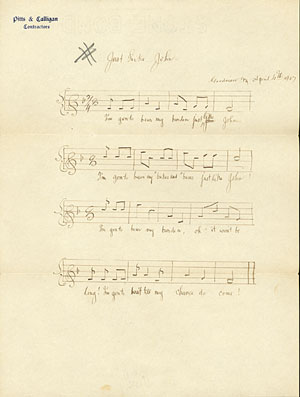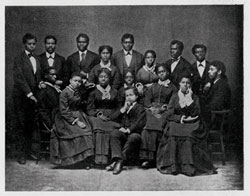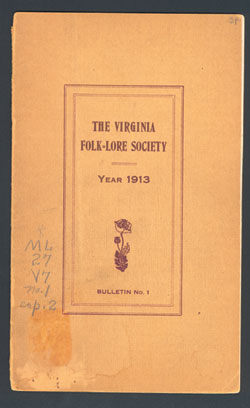|
|
|
|
| |
|
|
BEFORE RECORDINGS - EARLY COLLECTING
Before the advent of sound
recordings late in the nineteenth century, traditional music was
documented in manuscript or printed forms. Music publishers printed
piano arrangements of traditional American and British tunes to play
in drawing rooms and parlors in middle-class homes. Published tune
books documented the religious music sung in congregations across
Virginia and the South. Publishers also recorded the songs of
America's first indigenous musical theater-minstrelsy-which was itself
partially based on the "collecting" of African American music in the
South and Virginia.
|
The first systematic
collecting of traditional music forms in Virginia by researchers began
late in the nineteenth century. The most important of these collecting
efforts focused on Anglo-American balladry and African American
folksongs, especially the spirituals of the slaves. One of the first
black spirituals to be published-"Let My People Go," sometimes
referred to as "Go Down Moses"-was collected from escaped slaves who
gathered at Fort Monroe in Hampton, Virginia, during the Union army's
occupation in 1861. African American schools founded after
emancipation such as Fisk University and Hampton Normal and
Agricultural Institute (now Hampton University) developed singing
groups to raise funds through northern and European tours. Both sought
to counter the distorted images of African Americans found in minstrel
shows. Black folklorists and composers researched slave songs as a
vital cultural and artistic expression of African American life.
|

|
Attorney Charles
Montriou Wallace Jr. began collecting songs, mostly from Virginia,
sung by African Americans in the 1870s.
Library of Virginia
|
 |
Two of the earliest
collecting groups in Virginia were the Hampton Folk-Lore Society
(founded 1893) and the Virginia Folk-Lore Society (founded in 1913).
Alice Mabel Bacon, a teacher at Hampton Institute, established the
Hampton Folk-Lore Society, and most of the society's members and
collectors were students, graduates, and teachers at the institution,
whom Bacon trained as folklorists. The work of the society became a
popular feature of the institute's publication, the Southern Workman.
|
|
The Hampton Singers sang spirituals
to appreciative audiences and raised money for the newly formed
Hampton Normal and Agricultural Institute. ca. 1872
The Library of Virginia
|
One of the earliest state folklore
societies in the United States, the Virginia Folk-Lore Society focused
its early collecting on ballads as defined by Francis James Child in
his five-volume work, The English and Scottish Popular Ballads (1882-1898). The society's archivist, Arthur Kyle Davis Jr., edited
and published fifty-one ballads, songs that told a story, gathered
under the auspices of the society in Traditional Ballads of Virginia.
He also included versions of songs collected by Englishman Cecil J.
Sharp, who traveled through Appalachia in 1917 and later published a
collection with pioneer ballad-hunter Olive Dame Campbell. Folklorists
regarded the Appalachian region as a prime area for collecting ballads
in America, because they assumed that the isolation of the mountains
had preserved the culture and songs of the British emigrants.
|
 |
| |
The Virginia Folk-Lore Society's
early bulletins emphasized the group's collecting of Anglo-American
ballads.
Library of Virginia. |
| |
|